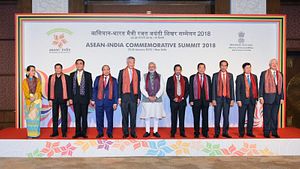Indian Prime Minister Narendra Modi was in Thailand recently for three major summits – the India-ASEAN Summit, the East Asia Summit, and the Regional Comprehensive Economic Partnership (RCEP) Summit. His visit was focused on a number of issues such as trade and connectivity, as well as security partnerships.
India’s diplomatic establishment was keen to highlight this aspect of India’s engagement of ASEAN. The Ministry of External Affairs (MEA), in a special press briefing on Modi’s visit, said “The ASEAN-related summits are an integral part of our diplomatic calendar,” highlighting the fact that this was Modi’s ASEAN-India summit and sixth East Asia Summit.”
With India’s renewed focus on Southeast Asia with the Act East Policy, this should not surprise anyone. But while India sees a central role for the ASEAN in its Indo-Pacific strategy, it also needs to be cognizant of the fact that ASEAN has its own limitations.
India has been keen on warming up its ties to Southeast Asia since the end of the Cold War. It initially adopted what was called the “Look East” policy which emphasized trade and economic linkages, but over the last decade this relationship has evolved into one that is at least equally concerned with security and strategic considerations. The policy was rebranded as “Act East” under the Modi government, to emphasize greater activism and commitment on India’s part. In January 2018, India hosted the 25th anniversary of the India-ASEAN friendship and the 15th year of the India-ASEAN summit, in which all the ten ASEAN leaders participated.
Clearly, this new approach is dictated by India’s concern about China. But if that is so, it is not clear how far ASEAN will or can go in balancing China. ASEAN’s tepid reaction to the ‘Indo-Pacific’ concept is reflective of the ASEAN’s wariness in annoying China. Earlier in the year, ASEAN did release its “Outlook on the Indo-Pacific” document, which was appreciated by New Delhi, which saw this as converging with its own Act East policy. But managing China would require a more coherent strategy and ASEAN has not been able to present a unified front when it comes to China. This division within ASEAN will likely only get deeper as Beijing becomes more muscular.
Thus far, in the face of China’s extensive economic linkages with the region, ASEAN has found it harder to take strong positions against China. While it has been particularly hard for smaller countries like Cambodia and Laos, even bigger players such as Malaysia have said they cannot afford to confront China. Most recently, the Malaysian Prime Minister Mahathir Mohamad said that “Malaysia does not want to take a confrontational stance toward China over the disputed South China Sea and Beijing’s alleged mistreatment of its minority Uighur Muslims.”
In the face of a divided ASEAN, India needs to strengthen its engagement with the region through other but associated platforms such as the East Asia Summit which includes key Indo-Pacific powers such as Australia, Japan and the United States. Many analysts believe that despite East Asia Summit being a key leaders forum, it has never gained the kind of traction that APEC or the G-20 has. However, they argue that it has the potential to become a major platform because of the “broad remit” it enjoys and the “inclusive” nature of the institution.
Other initiatives proposed by India also bear careful watching. At this year’s East Asia Summit, Modi proposed a new initiative called the Indo-Pacific Oceans Initiative, which is a reiteration of India’s commitment towards a free, open and inclusive Indo-Pacific region based on a rules-based order. The new initiative enlarges the focus on the strategic maritime space in the Indo-Pacific and is also a clear indicator of India’s willingness to address China’s maritime aggressiveness in an emphatic manner. The proposal was reportedly welcomed by ASEAN’s outgoing chair, Thailand, as well as Australia. Vijay Thakur Singh, Secretary of the MEA, detailed Modi’s new initiative as “creating partnerships among interested States in several pillars ranging from enhancing maritime security to preserving and sustainably using marine resources, building capacity, disaster prevention and management as well as working together in trade and maritime transport.”
On the sidelines of these summits, there was also a consultative meeting of the Quad countries where the Quad members reiterated “their commitment towards a free, open, prosperous and inclusive Indo-Pacific Region based on shared values and principles and respect for international law” while reflecting on “ongoing and additional practical cooperation in the areas of connectivity and infrastructure development, and security matters, including counterterrorism, cyber and maritime security, with a view to promoting peace, security, stability, prosperity in the Indo-Pacific region.” This came in the backdrop of a status report on the Indo-Pacific strategy from the U.S. State Department which also highlighted a “critical role” for India in the Indo-Pacific.
New Delhi is likely to continue to engage in large regional meetings and summits, but is probably also likely to step up engagement at bilateral and trilateral levels as well as the Quad and other minilaterals. A thicket of overlapping partnerships with like-minded partners is a better bet than following just single-track partnership with ASEAN alone. In order to develop concrete ideas on the Indo-Pacific Oceans initiative, India’s efforts cannot be limited to a normative exercise alone. Strategic partnerships with other key (and financially more capable) Indo-Pacific powers such as Japan has also become crucial.

































